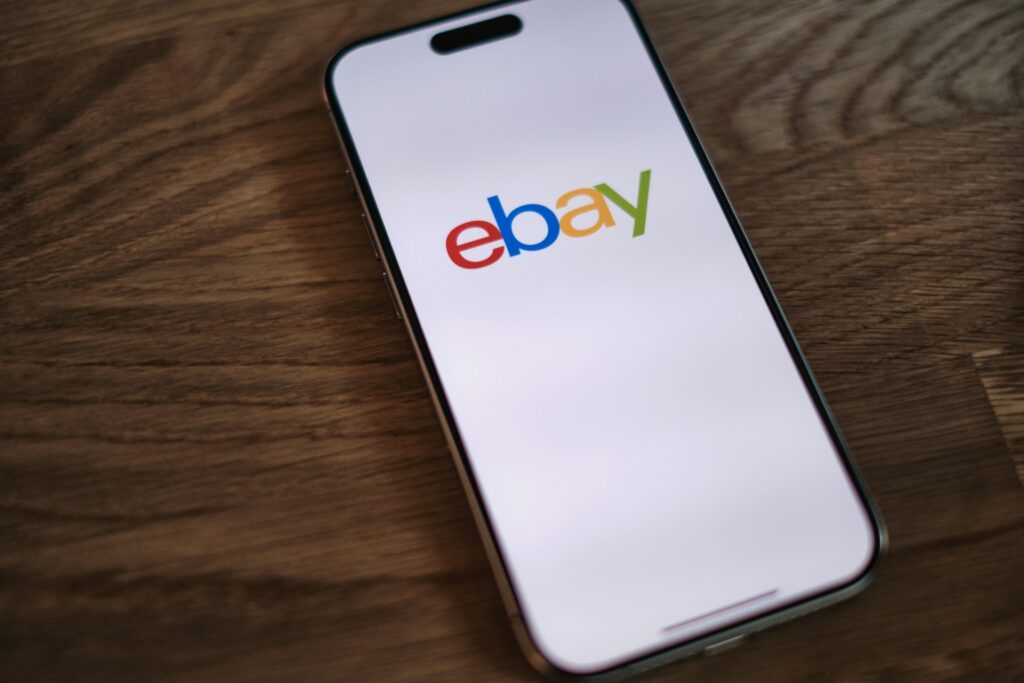- Blog
-
For Sellers
The complete guide to selling on eBay
eBay’s not just alive, it’s thriving. And the sellers who adapt to its playbook are reaping the rewards.

$19.5 billion in Gross Merchandise Volume. That’s what eBay racked up in Q2 2025 alone. With 2.4 billion listings and 134 million active buyers generating $2.7 billion in revenue, eBay remains a powerhouse marketplace for sellers looking to dive into ecommerce or expand their selling channels.
The numbers tell an even more compelling story: eBay now runs on 100% renewable energy for all operations and has raised over $662 million for nonprofits worldwide through eBay for Charity from 2021 to 2024. The company isn’t stopping there. They’ve set an ambitious net-zero emissions target for 2045, reinforcing their commitment to sustainability alongside their marketplace success.
It’s clear that eBay has evolved dramatically from its auction-house roots. So, are you ready to tap into this marketplace? Let’s break down exactly how to start and succeed as an eBay seller in 2025.
Do people really buy from eBay?
You bet. eBay operates globally in over 190 countries, so sellers have the opportunity to reach a huge audience. And aside from being a flexible ecommerce marketplace model, eBay buyers enjoy cheap prices on not only pre-owned or secondhand items, but across varied categories, especially household products.
Should I consider selling on eBay?
Why not? The thrill of tapping into the marketplace with millions of opportunities and over 18 different categories alone is a compelling reason to start selling on eBay. Moreover, setting up a seller account and listing your products on eBay is like spreading melted butter on a slice of bread—so easy.
Furthermore, eBay’s marketplace model allows all types of sellers to take advantage of the platform. You could be a manufacturer of industrial equipment, a small handicraft business, or someone wanting to sell extra stuff lying around your house.
There is no set level of success on eBay. It is up to you to determine how successful you will be. What starts as a declutter project might end up becoming a steady side hustle. It might be enough to replace your current income completely!
Before you register yourself as an eBay seller, whether you’re a beginner or an experienced ecommerce vendor, let’s understand the basics of the business model.
Business models on eBay
As we know, eBay is a multi-vendor online marketplace that connects millions of buyers and sellers from all over the globe to buy and sell new or used products, both on the website as well as the mobile app. Here are the main categories:
- Used items: Everything you can think of, from furniture to Lego, is probably currently listed on eBay.
- New items: Any item, new or never used, falls under the New Item category.
- Cars: eBay states that about 7.4 unique visitors a month browse their platform looking for cars. To learn more about selling cars on eBay, visit eBay Vehicle Seller Central.
- Art, antiques, and handicrafts: Many art and craft enthusiasts use eBay not only to buy supplies but to fund their interests by selling their own creations.
- Collectibles: Rare coins, stamps, limited-edition watches, vintage toys, autographed items, and any other memorabilia. eBay appeals to customers seeking good deals and hard-to-find products.
What value does eBay offer?
Accessibility, customization, risk reduction, and brand/status are the four primary value propositions eBay offers to both buyers and sellers.
Accessibility: eBay is a proven channel through which individuals can provide and obtain items that might be difficult to find due to various challenges.
Customization: eBay enables sellers to personalize their listings through auction-style and fixed prices. They can also specify item conditions in a wide variety of ways as new, used, refurbished, rare, branded, and unbranded. Buyers also get to choose between picking up their packages and having them dropped off at an address.
Risk reduction: Money Back Guarantee, Seller Performance Standards, Verified Rights Owner Program, and Feedback Forum are special programs through which eBay ensures the safety and protection of buyers and sellers.
Brand/status: eBay is known to be the second-largest ecommerce marketplace, and has been well-known since its launch.
How to start selling on eBay
As one of the world’s most popular ecommerce websites, eBay sellers must face stiff competition. But don’t you worry! We’ve got you covered with this extensive guide.
Let’s learn how to create a seller account on eBay in simple steps.
Step 1: Create an account.
First of all, let’s find out if you are eligible to sell on eBay by verifying your registered address in any of the countries, regions, or overseas territories in the list provided by eBay.
After determining your eligibility, you can create a seller account by registering either a personal account or a business account. If you want to sell the extra stuff lying in your attic, creating a personal account is probably the best option for you. If you have a registered business, you can set up an official business seller account that comes with added perks.
Step 2: Create a user ID.
Once your account has been created, you’ll be asked to create a user ID or username. Your ID will be displayed to every user, so choose one that is professional and reflects what your business stands for.
Step 3: Set an automatic payment method.
After creating your User ID, you’ll be prompted to set up an automatic payment method, which includes PayPal, a checking account, or a credit/debit card.
To set up a new or existing payment method, follow the simple steps as listed by eBay.
Step 4: Create a listing.
Creating a listing is the first step in getting your item in front of buyers. But, before you create one, let’s get you familiar with the basics to prevent any troubles in the future.
You have two options to list an item for sale on eBay: the quick listing tool or the advanced listing tool.
For your first listing, the quick listing tool may be the better choice as it offers pricing and shipping guidance based on previous sales of similar items. However, if you plan on frequently selling on eBay or have a large inventory, it may be more beneficial to use the advanced listing form due to its additional features.
Quick listing tool: Using the quick listing tool, you can easily identify your product by entering descriptive words or its UPC or ISBN code in the search bar. eBay will then suggest listings based on previously sold similar items.
Once you find the listing that matches your product, you can edit the existing fields to customize it with information that best suits your product.
Advanced listing tool: With the advanced tool, you can identify your product by typing relevant keywords into the search bar and clicking on “Get started.” If you’re unsure which keywords to use, you can click “Browse categories” and select the most fitting category and subcategories for your item.
For instance, if you’re selling a book on eBay, you can select its genre.
Once you’ve selected the genre, a form will be generated that you must fill in about your items. We have listed a few best practices ahead to help you create a flawless listing.
- Use a title that includes the most important, compelling information about the item.
- Fill in product identifiers, such as UPCs and ISBNs.
- Provide item specifics, including size, make, model, and color.
- Include up to 12 high-quality photos taken in a well-lit area against a white background.
- Write a clear and concise item description that answers any questions a buyer may have, using simple formatting and bullet points for ease of reading.
Listing types
eBay originally focused on auction-style sales for used items during its initial setup. Nonetheless, you can also list fixed price or ‘Buy It Now’ listings. This implies that you set a price and ship an item as soon as an order is placed.
Pros of auction listing:
- Fast-moving inventory
- Great for rare and collectible items
- Prices skyrocket on auctions for valuable items
Pros of fixed price listing:
- More automation
- Best offer feature
- Immediate payment guaranteed
Selling cost and other fees
eBay will automatically deduct your fees and other selling costs from your sales proceeds. However, you must have a valid payment method set up to cover these costs in case your sales proceeds do not cover them.
Valid payment methods include a debit or credit card or a linked payout bank account. If your funds are insufficient, eBay will charge your on-file payment method within 14 days and may combine the amounts you owe into a single charge.
eBay has a detailed guide on how they charge the sellers for selling costs and other fees.
There are different types of optional and mandatory fees charged by eBay. There are two that all the sellers must be aware of:
- Insertion fee: Before you sell an item on eBay, you will need to pay a listing fee. Each month, sellers can list up to 250 items for free. For any additional items, eBay will charge a flat fee of $0.35 per listing. However, if you opt for a monthly store subscription, this fee can be lowered.
- Find value fee: When you successfully sell an item, eBay will charge a percentage of the final sale price. The exact percentage is determined by the product category under which your item was listed. The fee starts at 5% depending on the category.
eBay selling policies
If you violate eBay’s policies, your listings may receive less visibility, and, in severe cases, your account may be suspended. Although some rules may seem self-evident, others may be less apparent. To avoid these issues, we suggest reviewing eBay’s selling policies before beginning to sell. Below are some significant mistakes to steer clear of:
- Don’t sell banned items, such as drugs, alcohol, counterfeit products, or recalled items.
- Don’t use product images taken from other websites.
- Don’t try to close any sales outside of the eBay platform.
- Avoid canceling customer orders.
- Avoid late shipments.
- Don’t ignore buyer complaints.
- Don’t list contact information, external links, or misleading information in listings.
If your eBay seller account gets suspended, you can reinstate your account depending on the reason why it was suspended in the first place. To understand more about why your account can get suspended and how it can be reinstated, we recommend going through eBay’s guide thoroughly.
Step 5: Setting prices for your products.
Securing your first sale is essential as it helps establish your reputation and boosts your visibility in eBay’s search rankings. Potential buyers often prioritize pricing and may sort search results from the least to the most expensive, which means that a lower-priced item could improve your ranking. Conversely, higher-priced items may appear lower in search results. It’s crucial to price your item as low as possible, but not suspiciously low, to avoid discouraging buyers.
Although pricing your items lower may reduce your profit margin, it is a strategic move. Lower-priced items often sell faster, which leads to increased sales and higher placement in eBay’s search results. As you gain traction and establish yourself as a seller on eBay, you can gradually raise your prices while retaining a prime position in search rankings.
Step 6: Packaging and shipping your orders.
After a sale on eBay, sellers need to purchase a shipping label, enter tracking details, and package the item for shipping. The process is best done from a computer unless your phone can connect to a printer.
eBay provides a simple system to purchase shipping labels by entering the weight and dimensions of the package already provided in the listing. It is important to have packing supplies on hand to ensure prompt order fulfillment, which customers love.
Effective packaging can enhance customer satisfaction and frequently encourages buyers to leave positive feedback for sellers. However, it is essential that the product inside matches the description in the listing.
We’ve summarized the supplies you’ll need to fulfill your eBay orders below:
- Shipping boxes and/or envelopes can be purchased from Walmart, Target, Home Depot, or office supply stores.
- USPS provides free shipping boxes at its post office.
- Only use USPS boxes when shipping with USPS.
- Adhesive shipping label paper makes it easy to print, peel, and stick labels on packages.
- UPS offers free shipping labels.
- Packing tape should be kept on hand.
- Protective inserts and padding, like packing paper or bubble wrap, should be used to ensure items arrive in the same condition they were sold.
- Packing materials from received packages can be reused.
- A package scale is necessary to ensure the correct package weight for accurate shipping fees
Become an advanced eBay seller
Here are some useful tips to become an advanced eBay seller:
1. Fulfill the order immediately.
Ship every product as soon as the payment is verified so as to maintain promptness. The wait time between “confirmation” and “shipped out” can feel long for a buyer.
In case you do not receive payment, don’t hang in between for more than a couple of days. Act proactively by contacting the buyer to understand what went wrong and where. If the buyer does not respond to the message or invoice, report the unpaid item to eBay.
2. Establish trust at every point of sale.
Trust is an integral part of growing any business. If you are a beginner with little to no transactional history, the trust factor becomes highly crucial. There are a few ways by which you can quickly establish trust:
- Fill out all forms correctly and add a profile photo or a brand logo.
- Add original pictures and videos of all the products in your listings. If you are uploading a used item, upload pictures of scratches or dents that accurately show the product.
- Display product reviews.
- Follow a smart pricing strategy by starting out with a lower price margin and, eventually, raising it for optimum profit.
3. Promote your listings.
Creating a promoted listing is a step towards becoming an experienced seller on eBay.
Once you select the item you want to promote on eBay, the platform will generate an ad automatically.
The seller needs to determine the ad rate, which is the percentage of the item price that they are willing to pay for promotion. The ad rate can be set as low as one percent.
The ad rate helps eBay determine if it should promote your listing when a buyer searches for the item or a similar one. The higher the ad rate, the more likely eBay is to promote your listing.
eBay provides information on ad rate trends by country and category for every type of seller with an Above Standard or Top-Rated Seller.
4. Offer 30-day returns and timely returns.
Nothing builds trust like return and refund policies—a free mail return voucher is like a chef’s kiss for a buyer.
5. Join social media seller groups.
The platform is constantly evolving to stay on par with the ongoing technological innovation in the world of ecommerce. This means that you must stay up to date with changing algorithms and buying trends. There are quite a few groups on Facebook and LinkedIn.
You can implement social media marketing strategies to promote your products.
6. Request ratings and feedback from your buyer.
By providing your buyers with excellent service, you can increase your confidence in requesting their feedback, which will enhance your credibility as a seller. Positive feedback can also help you learn from any mistakes and avoid future negative experiences. Additionally, requesting feedback presents an opportunity for you to interact with the buyer and address any questions they may have.
Now you’re ready to take eBay by storm
The beauty of eBay? It rewards experimentation. Try different shipping options, adjust your pricing, and test promotional strategies to see what works for your specific items.
What begins as a closet cleanout can grow into something much bigger. Many successful eBay businesses started with just a handful of listings and scaled from there.
Ready to take your eBay selling to the next level? Multichannel Pro handles everything from listing management to inventory syncing across eBay and other platforms—all from one dashboard. Stop juggling multiple systems and start selling more efficiently.
Book a free demo of Multichannel Pro and see how much easier selling on multiple channels can be.






















